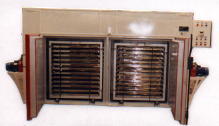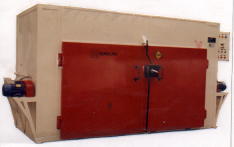Batch Type Dryers uses a perforated belt to transfer feed materials through the dryer. Heated air is either passed under and through, or over and through the belt and product bed before being reheated and re-circulated. Units are normally multi zoned and may have differing airflow's in successive zones. Additionally each zone may use a different temperature profile and control. Saturated or close to saturated air is exhausted from the dryer via a central exhaust duct.
Batch Type Dryers may be multi pass units, in which the feed is transferred from one belt to another belt below it by gravity. These dryers are usually two or three pass machines. Additionally certain conveyor dryers, such as those used in vegetable dehydration have multiple belts in line, and the feed is transferred from one belt to another.
Feeding / discharge Manual, batch, automatic and continuous. Vibrators, oscillating feeders, gravity chutes Feed Characteristics Large granules, agglomerates, pellets, preformed (extruded) products (pressure agglomerates), small solid particles, large solid particles, agricultural products. Low to high feed rates
Heat Source Steam, electrical, coal, liquid fuels, or gas Exposure Mostly Direct. Flow can be through the bed (under to over, over to under, or both), cross, counter current or co-current. Indirect systems available for certain products. Residence time Highly Controllable. Residence time can be altered by varying the feed and discharge rates affecting the bed depth. Belt can be slowed and modulated.
Extraction Normally central induced. Re-circulating fans used in each zone.
Exhaust connected to common header
Dust Collection
Typically little required. For fine product a central bag house is sometimes used.
Control
PLC control for each zone, infrequently solid state controllers.
System controls on above bed temperature. Can modulate energy.

